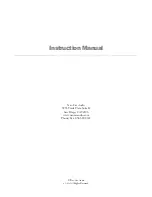
10
curtain of sound between them, your room’s reflections and/or seating distance is destroying the
coherent sound that was engineered into the VR design. To eliminate this unwanted effect, you will
need to determine whether the room’s reflections are at fault, or whether you are not in the “sweet
spot.”
To find the focal point of the VR system, move forwards and backwards slowly while listening to the
pink noise “ball.” You can either rock in your listening seat, or move back and forth by several feet if
you are way out of the equilateral triangle. Using a director’s chair for this works best, as it is easy to
move. If you have a fixed seating position that can not be moved due to furniture considerations, you
will have to move the speakers either closer together, or further apart, depending on the strength of the
pink noise “ball.” If your former speakers were placed close together to achieve center fill, try
spreading the VR-4SR Mk2’s further apart. Their wide dispersion enables a larger sound stage.
*Note: if the speakers can not be separated more than a few feet due to room considerations,
as in a video application, it may be necessary to toe the speakers
outwards
in order to gain a
wide sound stage and reduce the tendency towards monophonic image focus.
When placing the speakers further apart than 8 feet, try toeing them in towards you, listening for the
“ball” to lock in. It really helps to have two people moving the speakers while you sit in the listening
position, giving them orders. Toe-in is often critical, with only 1" movements being very apparent.
When you have found the correct spacing and listening distance, you will immediately know it, since
the image lock-in is very obvious. The pink noise will become a very strong “ball” of sound, floating
in between the speakers. Keep moving the speakers until you hear this ball of sound. As you move the
speakers either closer together or further apart, and experiment with toe-in, you will hear changes that
enable you to know if you are headed in the right direction.
It isn’t really difficult, it’s fun. Of course, experimenting with several types of placement schemes is
valuable, for it will teach you how the speakers interact with your particular room. Only by careful
experimentation will you find that “magic” sweet spot for your new VR-4SR Mk2 speaker system.
REAR AMBIENCE DRIVER ADJUSTMENT:
The VR design has a rear-firing ambience driver which adds depth enhancement and 360-degree
timbre fill-in. When breaking in the speakers, leave the Spatial Dimension Control all the way up in
order to break-in the driver fully. However, when optimizing the imaging using the pink noise test
documented above, turn the ambience driver off by rotating the control fully counter-clockwise.
Once the speaker location has been determined, it is time to add some rear ambience. While listening
to a variety of naturally recorded music, dial in successively more ambience, listening carefully to the
change. If your rear wall behind the speakers is highly reflective, only a little ambience will be
necessary if the speakers are fairly close to the wall.
In some situations, where the rear wall is highly reflective and the driving amp/cables are somewhat
overly detailed, it may be possible that
no
rear fill is necessary nor desirable. If you hear “brightness”
creep into the overall balance, it may be time to back off on the Spatial Dimension Control. In a room
that’s fairly dead, with soft sounding gear, it may be necessary to use the Spatial Dimension control
fully on.

































